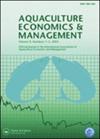根据养殖场数据制定海洋水产养殖的生产和财务基准
IF 3.7
2区 经济学
Q1 AGRICULTURAL ECONOMICS & POLICY
引用次数: 0
摘要
摘要农民已经使用作物和畜牧场的基准计划来确定提高农场效率的方法。这项研究为缅因州(美国)的牡蛎、贻贝和海藻养殖制定了一套基准。农场层面的调查数据用于计算每个农场受访者的基准衡量标准。结果表明,按生产规模、齿轮类型和农场是否为初始启动(本研究中定义为5 多年的商业生涯)农场。对单个农场成本结构的初步分析提供了有用的信息,可以据此确定需要分类的关键类别。确定最重要的成本投入进一步指出了哪些基准对不同的农场群体具有最大价值。牡蛎养殖场的结果显示,在已建立的底层养殖场,每只收获的牡蛎的启动成本最低(0.20美元/只),而已建立的暂停养殖场的启动成本为0.96美元/只,在已启动的牡蛎养殖场,启动成本最高(1.75美元/只。已建立的底层牡蛎养殖场的每只牡蛎的利润(农场净收入)最高,其次是已建立的暂停养殖场,但初创养殖场的平均利润为负。然而,每公顷已建立的悬浮养殖牡蛎养殖场的利润高于底层养殖牡蛎养殖。已建立的暂停养殖的牡蛎养殖场的劳动效率最高(65只牡蛎/小时),其次是已建立的底层养殖牡蛎养殖场(55只牡蛎/时),初创牡蛎养殖场劳动效率最低(44只牡蛎/工时)。鉴于水产养殖场之间固有的可变性,在每个生产规模/设备类型和启动/建立的类别中,有必要对参与养殖的农民进行足够数量的观察,以使基准具有价值。对于新兴的水产养殖部门,基准测试指标可能有助于度过关键的启动期,但获得足够数量的观测数据是一项挑战。已建立的农场企业的基准指标为成功所需的生产水平和经济表现提供了指导。总的来说,如果以整体的方式应用基准值,并考虑到农场在所有生产、收入、费用和效率类别(劳动力、资本和财务)中的表现,基准值是最有用的。本文章由计算机程序翻译,如有差异,请以英文原文为准。
Developing production and financial benchmarks for marine aquaculture from farm data
Abstract Benchmarking programs for crop and livestock farms have been used by farmers to identify ways to improve farm efficiencies. This study developed a set of benchmarks for oyster, mussel, and seaweed farming in Maine (USA). Farm-level survey data were used to calculate benchmarking metrics for each farm respondent. Results showed the importance of disaggregating benchmarking metrics by production scale, gear type, and whether farms were initial startup (defined in this study as <5 years in business) or established (>5 years in business) farms. The initial analysis of cost structures on individual farms provided useful information from which to identify key categories for disaggregation. Identification of the most important cost inputs further points to which benchmarks will be of greatest value for different groups of farms. Results for oyster farms showed that startup costs per oyster harvested were lowest ($0.20/oyster) on established bottom culture farms as compared to $0.96/oyster for established suspended oyster farms, and highest ($1.75/oyster) on startup oyster farms. Profits (Net Farm Income) per oyster were greatest on established bottom oyster farms followed by established suspended oyster farms, but were negative on average, for startup farms. Per-hectare, however, profits were greater on established suspended than bottom culture oyster farms. Labor efficiencies were also greatest for established suspended oyster farms (65 oysters/hour of labor), followed by established bottom culture oyster farms (55 oysters/hour of labor), with the lowest labor efficiency (44 oysters/hour of labor) for startup oyster farms. Given the inherent variability among aquaculture farms, adequate numbers of observations of participating farmers are necessary within each production scale/gear type and startup/established categories for benchmarks to be of value. For emerging sectors of aquaculture, benchmarking metrics can be useful for navigating the critical startup period, but obtaining sufficient numbers of observations is a challenge. Benchmarking metrics for established farm businesses provide guidance on the levels of production and economic performance necessary to be successful. Overall, benchmark values are most useful when applied in a holistic fashion that takes into consideration the performance of the farm across all production, revenue, expense, and efficiency categories (labor, capital, and financial).
求助全文
通过发布文献求助,成功后即可免费获取论文全文。
去求助
来源期刊

Aquaculture Economics & Management
FISHERIES-
CiteScore
7.30
自引率
17.90%
发文量
21
期刊介绍:
Aquaculture Economics and Management is a peer-reviewed, international journal which aims to encourage the application of economic analysis to the management, modeling, and planning of aquaculture in public and private sectors. The journal publishes original, high quality papers related to all aspects of aquaculture economics and management including aquaculture production and farm management, innovation and technology adoption, processing and distribution, marketing, consumer behavior and pricing, international trade, policy analysis, and the role of aquaculture in food security, livelihoods, and environmental management. Papers are peer reviewed and evaluated for their scientific merits and contributions.
 求助内容:
求助内容: 应助结果提醒方式:
应助结果提醒方式:


